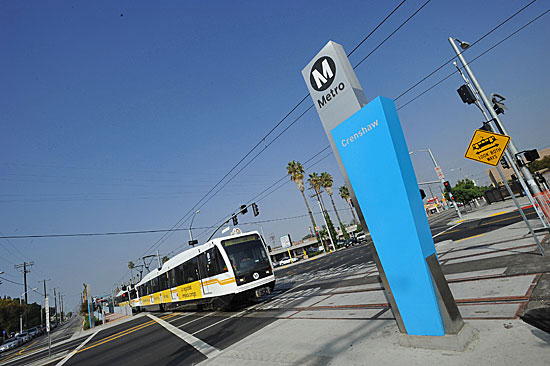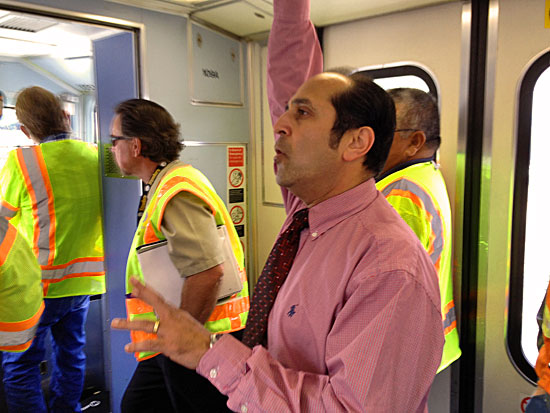Expo’s backstage safety patrol
April 27, 2012

With new Westside rail service, officials want to make sure that trains, cars and pedestrians safely co-exist.
Launch time for the Expo Line means crunch time for Vijay Khawani and Barbara Burns.
With the official opening this weekend of Expo’s first phase, Metro safety and education officials like Khawani and Burns have been working their way down a to-do list that, like the line itself, stretches from downtown to La Cienega.
And then there are the new things that keep cropping up.
Like the guy in the Maserati who ignored flashing signals and almost pulled out in front of an approaching train Tuesday.
Khawani, Metro’s Executive Officer of Corporate Safety, was out on the line with inspectors from the Public Utilities Commission when he spotted the car moving toward the tracks, so he raced down the station ramp toward it, waving his arms and yelling to get the motorist’s attention.
Crisis averted.
Making sure drivers, bicyclists and pedestrians stay alert around the trains—especially while they’re still something of a novelty—is a major preoccupation as Expo gets ready to roll.
Khawani and Burns, manager of Metro’s Transit Safety Education Programs, are key players on a team that must not only ensure that Expo meets all the regulatory requirements but also presents a safe and familiar image to the public in the line’s crucial early days and weeks.
For months, Burns has been deploying a small army of “safety ambassadors”—24 retired bus and rail operators—into communities around the new line to help people navigate the new system and to report back on trouble spots.
“We start one year before any train takes the track,” she said. “In the beginning, it’s always chaotic.”
To educate the public about what’s headed their way, Burns’ team has conducted dozens of training sessions at schools, senior centers and libraries and with neighborhood watch and community groups, sent out hundreds of notices about train testing, put up 4,000 safety posters and handed out 60,000 flyers door to door.
They’ve also placed safety ads on the sides of 20 trains—with bilingual messages such as “Hear bells? See lights? Train’s coming.”
“We started to do it with the Eastside Extension (of the Gold Line) and found it to be very effective,” she said. “It’s like a moving billboard.”
Still, some people don’t get the message. There have been three collisions involving Expo Line trains since testing began—all the result of motorists proceeding against a flashing red light signaling an approaching train, Khawani said. The most recent accident, on April 19, was caused by a driver making an illegal left turn, he said.
“That type of accident is actually the most common type of light rail accident in the industry across the country,” he said. “I think education is a big component because this is something that’s new in the neighborhood. They’ve never had trains.”
Common sense goes a long way, he said. There have been no serious injuries in the Expo crashes, but a brand new Mercedes Benz was totaled on March 19 when its owner got distracted “playing around with the new navigation system,” he said.
“We can’t do it alone,” Khawani said. “They’ve got to obey the signs.”
Large crowds are expected to ride Expo for free on its inaugural weekend, Saturday and Sunday, April 28 and 29. And before the light rail makes its public bow, a series of technical and mechanical fixes have been required.
An automatic routing system to make sure Expo and Blue Line trains—which share some stations in downtown L.A.—get on their respective tracks logged 20 “misroutes” on a recent day of testing.
So at least at the beginning, controllers in Metro’s Rail Control Center (known as “The ROC”) will be routing the trains manually.
“It’s a temporary fix until we can assure ourselves that the automatic routing function is working reliably. It’s not a safety concern, it’s more an operational concern,” Khawani said. “When you’re on a train for Long Beach, you don’t want to end up in Culver City”—an unlikely scenario, he added, because the train operator would almost certainly notice the misroute before reaching the end of the line.
Another major priority is making sure that trains don’t block intersections. That has meant getting the city Department of Transportation to change signal timing to give train operators some extra “green time” to proceed through intersections—first 10 extra seconds and then, as of Sunday, 4 more.
“Four seconds make a big difference,” Khawani said. “Since Sunday, we have not seen any trains blocking any intersections. It has improved it dramatically.”
A test run Tuesday with the PUC inspectors onboard was largely successful, although two signs at the Crenshaw station needed to be relocated so trains can proceed without getting stopped between stations.
At the La Cienega station, Khawani checked to see that emergency lighting required by the L.A. Fire Department was in place and working. (It was, and he snapped a photo with his phone.)
No detail, it seems, is beneath his attention. He called in a mistake he spotted at the Western station, where a pavement sign reading “Stay Behind Yellow Line” was accidentally transposed to read “Yellow Line Stay Behind.”
Animated but apparently unflappable, Khawani has seen 20 years’ worth of launches since he joined Metro. And he says he has never doubted that the Expo Line would open Saturday.
“This is very typical of all openings,” he said. Still, don’t expect him to let his guard down anytime soon. “I don’t think there is ever a time when you get to breathe a sigh of relief.”

Vijay Khawani, Metro’s Executive Officer of Corporate Safety, rides Expo with safety team and PUC inspectors.
Posted 4/26/12












 405 bridge work causes a stink
405 bridge work causes a stink

